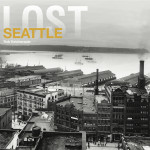Information about Washington freeway noise laws.
This is part of the special feature Freeway Box, showcasing my old life next to freeway viaducts.
WSDOT site on highway traffic noise. This contians a very clear definition of noise and how highway impact is determined. It also has helpful information about quieter car design. Then WSDOT discusses the need to limit development near freeways and build soundproof structures. While this is helpful for rural areas, it doesn't solve the problems for Seattle where we are increasing density and preserving historic structures. Soundproofing also does not create vibrant communities. It assumes people will be indoors when they participate in activities in which they need to hear.
Under the first "Noise Reduction on Existing Roads," the discussion of noise walls - as well as a look at the design standards - shows a confusing limit to WSDOT's use of noise barriers. All of their designs are hard materials in purely vertical alignements. In Europe and Asia I've seen extensive use of curved-topped walls, to further reflect the noise inwards. Also, there is often vegetation or plastic materials to absorb more of the noise. Sometimes plexiglass is used to allow people to see out, especially where emergency phones are located. I obviously have alot of reading to do here to understand why WSDOT hasn't considered these materials. Perhaps their real impact is negligable.
The author rightly points out that a simple noise barrier does nothing for vertical applications, when houses are above the freeway or when tall buildings are located next to the freeway.
Under the second "Noise Reduction on Existing Roads," the engineering features of a 200-foot wide vegetation barrier are presented. What is not discussed is the limits to its application in urban areas. The hillside next to Kobe Terrace Park is regularly sawed down, to reduce the number of homeless living in it. The apparent woodlands on the side of Beacon Hill next to I-5 is called The Jungle and is a famous camping zone for homeless. Recently they were cleared out after some theives and drug dealers started mixing in and forced the police to take action.
"Noise Reduction on New Roads" begins to show a heirarchy of uses and whether they will be mitigated for noise. The catch-all of "businesses" are clumped with "industrial." Street-oriented businesses certainly need to have noise mitigation to not dampen the environment for patrons walking on the sidewalk.
Here are the design standards for WSDOT, there are 20 noise barrier type designs presented.
Great WSDOT FAQ on noise barriers. There are some inconsistencies. This FAQ contradicts the general discussion article linked to above, saying that only 100 feet of vegetation would do the same work as a sound wall. It clarifies that WSDOT does not pay for insulation of buildings, and quotes a general cost per square foot.
Here's another summary of how, when, and why of noise walls. It's helpful but somehow ironic how each description of noise tells people how they can pay for abatement on their own.
Statewide traffic noise analysis and abatement policies and procedures. Real meat of how and when to deal with noise.
